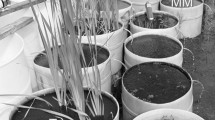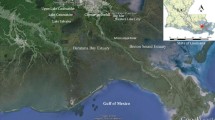Abstract
Tebuthiuron (N-[5-(1,1-dimethylethyl)-1,3,4-thiadiazol-2-yl]-N,N′-dimethylurea) appears to control the riparian shrub saltcedar (Tamarix spp.); however, its use is restricted since the fate and effects of this herbicide in aquatic systems are unknown. Possible tebuthiuron impacts on aquatic production were examined in ten 2846-1 three-phase, open-system mesocosms. Each mesocosm contained sediment, water, algae, micro- and macroinvertebrates and fish, and was open to the atmosphere for gas exchange and colonization by indigenous macroinvertebrates and algae. The following nominal doses of tebuthiuron were used: 0 (control), 10, 70, 200, 500, and 1000 μg 1−1. The 200 μg 1−1 dose approximated the highest concentration of tebuthiuron detected in a water body after experimental application to a watershed. Data generated from all treatment levels were used in tebuthiuron fate analysis and in correlation analysis between the mesocosm variables. The control and the 200 μg 1−1 treatment level were replicated (n = 3) to allow for additional statistical analyses of treatment effects at the 200 μg 1−1 level. The adsorption of tebuthiuron to sediments contained in ten mesocosms was described by the Freundlich equation, x/m = 3.24c0.68. Phytoplankton primary production, chironomid density, and chironomid biomass were negatively correlated with tebuthiuron concentration during peak system productivity. Conversely, no trends were observed at any sample date between an omnivorous fish species and herbicide concentration. At the 200 μg 1−1 dose level, only chironomid density was reduced. Factors responsible for reductions in chironomid density may include 1) a species shift in the 200 μg 1−1 treatment algal assemblages toward a greater percentage of ‘unpalatable’ biomass, and 2) decreased algal productivity and/or an algal species shift in mesocosms receiving dose levels greater than 200 μg 1−1. Chironomid density reduction at the 200 μg 1−1 dose level suggests that deleterious effects may occur in some stream systems exposed to a 200 μg 1−1 tebuthiuron concentration.
Similar content being viewed by others
References
Bowling, J. W., J. P. Giesy, H. J. Kania & R. L. Knight, 1980. Large-scale microcosms for assessing fates and effects of trace contaminants. In J. P. Giesy (ed.), Microcosms in ecological research, U.S. Dept. of Energy, Washington, D.C., DOE Symposium Series 52: 244–247.
Busby, F. E. Jr. & J. L. Schuster, 1973. Woody phreatophytes along the Brazos River and selected tributaries above Possum Kingdom Lake. Report 168, Texas Water Development Board, Austin (TX), 41 pp.
Canton, S. P. & J. W. Chadwick, 1983. Aquatic insect communities of natural and artificial substrates in a montane stream. J. Freshwat. Ecol. 2: 153–158.
Carpenter, S. R., J. F. Kitchell & J. R. Hodgson, 1985. Cascading trophic interaction and lake productivity. Bioscience 35: 634–639.
Coffman, W. P., 1978. Chironomidae. In R. W. Merritt & K. W. Cummins (eds), An introduction to the aquatic insects of North America. Kendall/Hunt Publishing Company, Dubuque (IA): 345–176.
Couch, R. W. & E. N. Nelson, 1982. Effects of 2,4 D on non-target species in Kerr Reservoir. J. aquat Plant Mgmt 20: 8–13.
Dill, L. M., 1983. Adaptive flexibility in the foraging behavior of fishes. Can. J. Fish. aquat. Sci. 40: 398–408.
Elanco Products Company, 1982. Transport of tebuthiuron in the environment: a position paper. Elanco Products Company, Indianapolis (IN), 7 pp.
Elanco Products Company, 1983. Graslan Technical Manual. Elanco Products Company, Indianapolis (IN), 179 pp.
Ferens, M. C. & R. J. Beyers, 1972. Studies of a simple laboratory microecosystem; effects of stress. Ecology 53: 709–713.
Giddings, J. M. & G. K. Eddlemon, 1979. Some ecological and experimental properties of complex aquatic microcosms. Int. J. Envir. Stud. 13: 119–123.
Goodyear, C. P., C. E. Boyd & R. J. Beyers, 1972. Relationships between primary productivity and mosquitofish (Gambusia affinis) production in large microcosms. Limnol. Oceanogr. 17: 445–450.
Hall, D. J., W. E. Cooper & E. E. Werner, 1970. An experimental approach to the production dynamics and structure of freshwater animal communities. Limnol. Oceanogr. 15: 839–928.
Hester, F. E. & J. B. Dendy, 1962. A multiple-plot sampler for aquatic macroinvertebrates. Trans. am. Fish. Soc. 91: 240.
Hyra, R., 1978. Methods for assessing instream flows for recreation. Instream Flow Information Paper No. 6, FWS/OBS - 78/34. Cooperative Instream Flow Service Group, Ford Collins (CO), 52 pp.
Johnson, R. R., 1978. The Lower Colorado River: a western system. Proceedings, Strategies for protection and management of floodplain wetlands and other riparian ecosystems. U.S. Dept. Agriculture-Forest Service, Gen. Tech. Rep. WO-12, U.S. Forest Service, Washington, (D.C.): 41–45.
Jones, V. E., C. H. Meadors, P. W. Jacoby & C. E. Fisher, 1978. Effect of pelleted herbicides on six hard to control brush species. Proceedings, Southern Weed Sci. Soc. 31st Annual Meeting, 31: 191–192.
Larner, D. C., R. M. Marshall, A. E. Pfluger & S. C. Burnitt, 1974. Woody phreatophytes along the Colorado River from southeast Runnels County to the headwaters in Borden County, Texas. Report 182, Texas Water Development Board Report, Austin (TX), 19 pp.
Lee, D. S., C. R. Gilbert, C. H. Hocutt, R. E. Jenkins, D. E. McAllister & J. R. Stauffer, Jr., 1980. Atlas of North American freshwater fishes. North Carolina Biological Survey, Raleigh (NC), 854 pp.
Lind, O. T., 1979. Handbook of common methods in limnology. The C.V. Mosby Company, St. Louis (MO), 199 pp.
Loh, A., S. D. West & T. D. Macy, 1978. Gas chromatographic analysis of tebuthiuron and its metabolites in grass, sugarcane, and sugarcane by-products. J. agric. Food Chem. 26: 410–413.
McConnell, W. J., 1965. Relationship of herbivore growth to rate of gross photosynthesis in microcosms. Limnol. Oceanogr. 10: 539–543.
Meier, P. G., D. L. Penrose & L. Polak, 1979. The rate of colonization by macroinvertebrates on artificial substrate samplers. Freshwat. Biol. 9: 381–392.
Moly, M. & E. Ruber, 1983. Effects of pesticides on pure and mixed species cultures of salt marsh pool algae. Bull. envir. Contam. Toxicol. 30: 464–472.
Morton, D. M. & D. G. Hoffman, 1976. Metabolism of a new herbicide, Tebuthiuron {1-[5-(1,1-Dimethylethyl)-1,3,4Thiadiazol-2-yl]-1,3-Dimethylurea], in mouse, rat, rabbit, dog, ducks, and fish. J. Toxicol. envir. Health 1: 757–768.
Murdoch, W. W., S. Avery & M. E. B. Smyth, 1975. Switching in predatory fish. Ecology 56: 1094–1105.
Peck, O. E., D. L. Corwin & W. J. Farmer, 1980. Adsorption — desorption of tebuthiuron by freshwater sediments. J. envir. Qual. 9: 101–106.
Pilson, M. E. Q. & S. W. Nixon, 1980. Marine microcosms in ecological research. In J. P. Giesy (ed.), Microcosms in ecological research, U.S. Dept. of Energy, Washington, D.C., DOE Symposium Series 52: 724–741.
Pflieger, W. L., 1975. The fishes of Missouri. Missouri Department of Conservation, Jefferson City (MO), 343 pp.
Price, D. J., B. R. Murphy & L. M. Smith, 1989. Effects of tebuthiuron on characteristic green algae found in playa lakes. J. envir. Qual. 18: 62–66.
Ryther, J. H., 1970. Is the world's oxygen supply threatened? Nature 227: 374–375.
Saether, O. A., 1980. The influence of eutrophication on deep lake benthic invertebrate communities. Prog. Water Techol. 12: 161–180.
Sheldon, A. L., 1977. Colonization curves: application to stream insects on seminatural substrates. Oikos 28: 256–261.
Smith, H. N. & C. A. Rechenthin, 1964. Grasslands restoration: the Texas brush problem. U.S. Dept. of Agric. Soil Conser. Serv., Temple (TX).
U.S. Dept. of Interior (USDI), 1959. Report on phreatophytes, for Senate Select Committee on Natural Water Resources. Dept. of Int., Washington (D.C.): 1–5.
U.S. Geological Survey (USGS), 1979. Water resources data for Texas. U.S. Geological Survey Water-Data Report TX-79–2. Austin (TX).
Vollenweider, R. A., 1974. A manual on methods for measuring primary production in aquatic environments. Blackwell Scientific Publications, Oxford, 225 pp.
Author information
Authors and Affiliations
Additional information
Contribution No. T-9-367 of the College of Agricultural Sciences, Texas Tech University.
Contribution No. T-9-367 of the College of Agricultural Sciences, Texas Tech University.
Rights and permissions
About this article
Cite this article
Temple, A.J., Murphy, B.R. & Cheslak, E.F. Effects of Tebuthiuron on aquatic productivity. Hydrobiologia 224, 117–127 (1991). https://doi.org/10.1007/BF00006868
Received:
Revised:
Accepted:
Issue Date:
DOI: https://doi.org/10.1007/BF00006868




